


BOTANY BAY - FIRST PENAL
SETTLEMENT
IN AUSTRALIA 1788
(G3b)
xxxxxIn 1788 Captain Arthur Phillip (1738-1814) arrived at Botany Bay, New South Wales,
with 760 convicts to open up the first penal settlement in
Australia. He eventually chose a site at Sydney Cove in Port
Jackson, near to Circular Quay in modern Sydney. Over the next forty
years, other settlements were established, including ones at Norfolk
Island, Tasmania (then Van Diemen’s Land) and Moreton Bay, near
Brisbane. Despite extreme hardship and outbreaks of violence,
Phillip, the first governor of New South Wales, managed to set up a
permanent community and, later, conditions somewhat improved as
sheep, cattle and arable farming were introduced. Meanwhile,
convicts who had served their time, together with legal immigrants,
formed colonies in Victoria, Southern Australia and around Perth on
the west coast. As we shall see, exploration of the interior was to
begin in earnest around 1840, at the beginning of the Victorian Age
(Va),
and it was to be during this period that gold
was discovered in a number of areas.
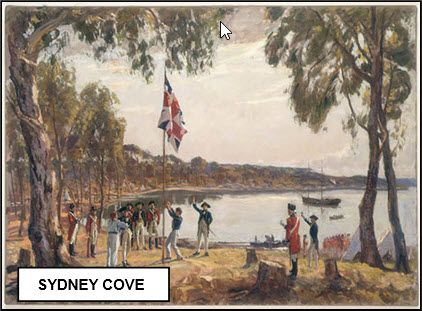 xxxxxIn 1783, following the victory of the
colonists in the American War of Independence, the British Government
had to find an alternative site for its penal settlement - an
area to which criminals could be “transported”. It chose the newly
discovered colony of New South Wales, situated in the land then known
as Terra Australis Incognita on the other
side of the globe.
xxxxxIn 1783, following the victory of the
colonists in the American War of Independence, the British Government
had to find an alternative site for its penal settlement - an
area to which criminals could be “transported”. It chose the newly
discovered colony of New South Wales, situated in the land then known
as Terra Australis Incognita on the other
side of the globe.
xxxxxThus it was that Captain Arthur Phillip (1738-1814)
arrived off the shores of Botany Bay in January 1788, with
760 convicts and some 200 marines aboard
eleven ships, six of them transport vessels. He landed close to the
spot where the English explorer James Cook had first set foot on the
continent in 1770, but decided that the area was unsuitable for
settlement. (Though for some years hence the name “Botany Bay” was
often used as a general term for a convict station). A few days
later he moved five miles up the coast to Port Jackson, situated in
what he described as “the finest harbour in the world”. Here he made
his settlement at “Sydney Cove” (illustrated), named after the then Home Secretary (close to the
present Circular Quay in Sydney), and raised the flag on the 26th
January - now remembered as “Australia Day”.
xxxxxIn 1803 Phillip opened a
second site on Norfolk Island, mainly for hardened criminals, and
later Van Diemen’s Land - renamed Tasmania in 1854 - was
made a penal extension. But settlement was not confined to the
south. In 1825 New South Wales set up a separate penal colony at
Moreton Bay, near Brisbane - the future capital of the new
colony of Queensland, established in 1859.
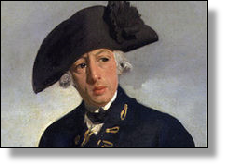 xxxxxAs can be easily imagined, the early years of settlement
proved a period of immense hardship. A large number of convicts, the
vast majority of whom were poorly educated and motivated, were
hardly an ideal population on which to build a flourishing society.
However, as the colony’s first governor, Phillip (illustrated) managed to create a permanent community, despite
outbreaks of disorder among convicts and troops, and the constant
threat of famine. And later, the introduction of sheep into New
South Wales for the production of fine wool, gave the colony an
expanding industry, and encouraged freed convicts (“emancipists”)
and legal immigrants to settle and take up sheep, cattle or arable
farming in the open plains beyond the Blue Mountains.
xxxxxAs can be easily imagined, the early years of settlement
proved a period of immense hardship. A large number of convicts, the
vast majority of whom were poorly educated and motivated, were
hardly an ideal population on which to build a flourishing society.
However, as the colony’s first governor, Phillip (illustrated) managed to create a permanent community, despite
outbreaks of disorder among convicts and troops, and the constant
threat of famine. And later, the introduction of sheep into New
South Wales for the production of fine wool, gave the colony an
expanding industry, and encouraged freed convicts (“emancipists”)
and legal immigrants to settle and take up sheep, cattle or arable
farming in the open plains beyond the Blue Mountains.
xxxxxNor were all the fringes of this vast continent
developed simply for the convenience of “transportation”. By the
1830s, convicts who had served their time on Van Diemen’s Land were
crossing onto the mainland. Here they founded the free settlement of
Victoria - made into a separate colony in 1851 - , whilst
further west the colony of South Australia, eventually made
economically viable by the introduction of wheat, was created by the
selling of land. Meanwhile, in the extreme far west the colony of
Western Australia was established by legal immigrants in 1829,
centred on today’s city of Perth on the Swan River. Furthermore, by
1844, following protests from the growing number of settlers, no
more convicts were sent to New South Wales. However Van Diemen’s
Land continued to be used until 1852, and by that time it was
estimated that some 150,000 prisoners had been transported to the
two colonies.
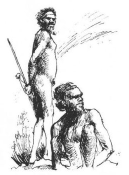
xxxxxBut, as noted, these
colonies, strung out as they were around the coasts of this huge
continent, were but “fringe” development. The vast interior was
known to its inhabitants, the Aboriginals, but had yet to be
discovered by the country’s new, European settlers. As we shall see,
exploration was to begin in earnest around 1840, at the beginning of
the Victorian age (Va), a
period which was also to witness the
discovery of gold in a number of areas.
xxxxxIncidentally,
the British settler and administrator David
Collins (1756-1810) wrote the first
history of Australia. Entitled An Account of the
English Colony in New South Wales, it was first published
in 1798. Later, William Charles Wentworth (1790-1872), the man who led a party across the
Blue Mountains, and later worked for home rule, produced the first
newspaper, the Australian, and wrote A Description
of New South Wales in 1817. ……
xxxxx…… As
we shall see, Captain William Bligh, the man faced
with the Mutiny on the Bounty in 1789, served as governor of New South Wales from 1806, and
found himself with another mutiny on his hands, this time among the
colony’s marine corps. In 1808 his name was cleared, but he did not
c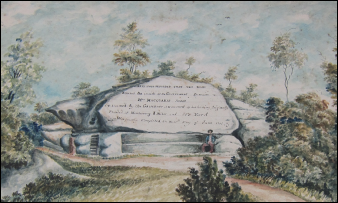 ontinue
as the governor. ……
ontinue
as the governor. ……
xxxxx……
Thexfollowing year he was replaced by a
much abler man, Lachlan Macquarie (1762-1824). Unfortunately, so we are told, his
wife was dreadfully homesick, and would often sit alongside Sydney
harbour, gazing out to sea. Today there is a stone seat - “Mrs
Macquarie’s chair” - to mark the place where she used to sit
and watch the ships departing for home. ……
xxxxx…… Such
was the crime rate in Britain at this time - particularly in
the cities - that transportation was introduced to relieve
overcrowding in the prisons. Although often reserved for the
political agitator or the hardened criminal, it was sometimes used
for the most trivial offence. On the stone bridge which crosses the
River Stour in the market town of Blandford Forum, Dorset, for
example, there is a notice to this day which reads: Any
person wilfully injuring any part of this County Bridge will be
guilty of felony and upon conviction liable to be transported for
life. ……
xxxxx……
The last shipment of British convicts landed in Australia in 1867.
Acknowledgements
Sydney Cove: by
the English artist Algernon Talmage (1871-1939), 1937 – State
Library of New South Wales, Sydney, Australia. Phillip: by the English portrait painter Francis Wheatley
(1747-1824), 1786 – National Portrait Gallery, London. Chair: by the English artist George Roberts (active 1836-1864),
contained in his album entitled The Holes and
Corners of Sydney As They Are and As They Were,
1836-1864 – State Library of New South Wales, Sydney,
Australia. Pérouse: detail, date and
artist unknown. Final Voyage: date and
artist unknown. Bass: date and artist
unknown, contained in The Naval Pioneers of
Australia by Louis Beck and Walter Jeffery, 1899. Map (Bass Strait): www.travelvictoria.com.au. Bull: by the English engraver Thomas Bewick (1753-1828),
1789 – Victoria and Albert Museum, London.
Including:
Arthur Phillip,
Jean La Pérouse
and George Bass

xxxxxThe French explorer Jean La Pérouse (1741-c1788)
visited Botany Bay in 1788, but, following his departure in March,
his two vessels were never seen again. In 1826 wreckage of the ships
was found off the present-day Solomon Islands, and there was
talk of a massacre of some 30 crewmen. Earlier, his exploration of
the Pacific Ocean, begun in 1785, had taken him as far north as the
Alaskan coast. Then, crossing westward by way of the Hawaiian
Islands, Macao and the Philippines, he had became one of the first
Europeans to enter Korean and Japanese waters. Here he discovered
the strait - later named after him - between the islands
of Sakhalin and Hokkaido. Before tragedy struck, he sent notes of
his travels back to France by an overland route, and these were
published under the title A Voyage Around the
World.
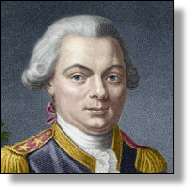 xxxxxIt was also in the year 1788 that the French explorer and naval officer Jean La Pérouse (1741-c1788)
visited Botany Bay. On his departure in March of that year, his two
vessels and their crews were never seen again, and it was not until
1826 that the wreckage of the two ships was found off Vanikoro
Island (now part of the Solomon group). Later it was learnt from the
islanders that 30 crewmen had been massacred there. The fate of the
other seamen remains a mystery.
xxxxxIt was also in the year 1788 that the French explorer and naval officer Jean La Pérouse (1741-c1788)
visited Botany Bay. On his departure in March of that year, his two
vessels and their crews were never seen again, and it was not until
1826 that the wreckage of the two ships was found off Vanikoro
Island (now part of the Solomon group). Later it was learnt from the
islanders that 30 crewmen had been massacred there. The fate of the
other seamen remains a mystery.
xxxxxLa
Pérouse served in the French navy for close on 30 years, and in 1785
was put in command of an expedition to explore the Pacific Ocean and
find a Northwest Passage from the Pacific side. He took his two
ships, L'Astrolabe and La
Boussole, as far north as the Alaskan coast and then, after
stopping at the Hawaiian Islands, Macao and the Philippines, became
one of the first Europeans to enter Korean 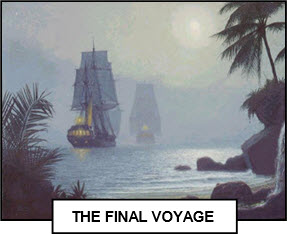 and
Japanese waters. It was here that he discovered the strait - later named after him -
that divides the islands of Sakhalin and Hokkaido. He then landed on
the Siberian peninsula of Kamchatka, and sent a party of men
overland to take the journal and maps of his travels back to France.
It was after this that he made his visit to Botany Bay, travelling
via the Samoan Islands - where a party of his men were murdered
- and the islands of Tonga and Norfolk. In the meantime, the
record of his extensive exploration in the Pacific reached France
safely, and was published in 1797 under the title A
Voyage Around the World.
and
Japanese waters. It was here that he discovered the strait - later named after him -
that divides the islands of Sakhalin and Hokkaido. He then landed on
the Siberian peninsula of Kamchatka, and sent a party of men
overland to take the journal and maps of his travels back to France.
It was after this that he made his visit to Botany Bay, travelling
via the Samoan Islands - where a party of his men were murdered
- and the islands of Tonga and Norfolk. In the meantime, the
record of his extensive exploration in the Pacific reached France
safely, and was published in 1797 under the title A
Voyage Around the World.
xxxxxAmongxother explorers in Australian waters at this time was Bruni d’Entrecasteaux (1737-1793), one of the French
navigators who
went in search of La Pérouse. He surveyed the west and south coasts
of the continent in the early 1790s, together with parts of the
Tasmanian coastline.
In 1798, the English explorers George
Bass (1771-1803) and Matthew Flinders (of later fame)
circumnavigated Tasmania (then Van Diemen’s Land), finally proving
that it was an island. Bass, whose name was later given to the strait
between Tasmania and the mainland, joined the navy after practising as
a surgeon. Earlier, together with Flinders, he had explored the coast
of New South Wales south of Port Jackson, including Botany Bay. Having
a keen interest in plant and animal life, on returning to England in
1799, his notes and collections of specimens earned him membership of
the London Linnean Society.
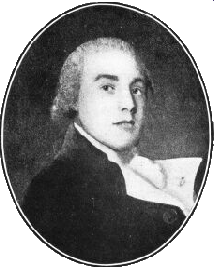 xxxxxIt was two Englishmen from Lincolnshire, the navigator George Bass (1771-1803)
and the naval officer Matthew Flinders (of later
fame) who
circumnavigated Tasmania in 1798 (then called Van Diemen’s Land) and
proved once and for all that it was an island.
xxxxxIt was two Englishmen from Lincolnshire, the navigator George Bass (1771-1803)
and the naval officer Matthew Flinders (of later
fame) who
circumnavigated Tasmania in 1798 (then called Van Diemen’s Land) and
proved once and for all that it was an island.
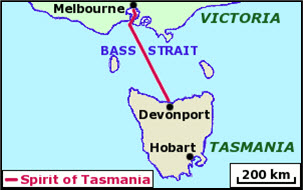 xxxxxBass, whose name was later given to the strait between
Tasmania and the mainland, started his career as a surgeon, but
later joined the navy and proved a good seaman. It was while serving
on the Reliance that he became friendly
with the mate, Matthew Flinders, and in 1795 they explored the coast
of New South Wales south of Port Jackson, including George’s River
and Botany Bay. Bass also possessed a keen interest in animal and
plant life. On his return to England in 1799, the year after his
successful circumnavigation of Tasmania, he was
elected to the Linnean Society of London on the strength of his
collection of specimens and the notes he had made on the swan, the
albatross and, more particularly, the Australian wombat. He later
became a trader, and was lost at sea in 1803 whilst on a journey
from Sydney to South America.
xxxxxBass, whose name was later given to the strait between
Tasmania and the mainland, started his career as a surgeon, but
later joined the navy and proved a good seaman. It was while serving
on the Reliance that he became friendly
with the mate, Matthew Flinders, and in 1795 they explored the coast
of New South Wales south of Port Jackson, including George’s River
and Botany Bay. Bass also possessed a keen interest in animal and
plant life. On his return to England in 1799, the year after his
successful circumnavigation of Tasmania, he was
elected to the Linnean Society of London on the strength of his
collection of specimens and the notes he had made on the swan, the
albatross and, more particularly, the Australian wombat. He later
became a trader, and was lost at sea in 1803 whilst on a journey
from Sydney to South America.
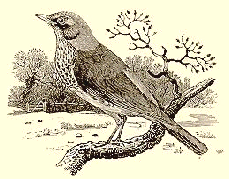 xxxxxIncidentally, a couple of
years before Bass returned to England with his bird and animal
specimens, a book entitled British Land Birds
was published. It was remarkable above all for the superb
illustrations it contained, provided by the English bird watcher and
amateur naturalist Thomas Bewick (1753-1828), and based on his own water colour
paintings from nature. A printer by trade and known for his pioneer
work in the art of wood engraving, he later provided illustrations
for British Water Birds, produced in
xxxxxIncidentally, a couple of
years before Bass returned to England with his bird and animal
specimens, a book entitled British Land Birds
was published. It was remarkable above all for the superb
illustrations it contained, provided by the English bird watcher and
amateur naturalist Thomas Bewick (1753-1828), and based on his own water colour
paintings from nature. A printer by trade and known for his pioneer
work in the art of wood engraving, he later provided illustrations
for British Water Birds, produced in 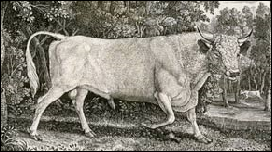 1804.
In recognition of his work, a distinctive breed of swan was named
after him in 1830. Apart from birds, he also illustrated an earlier
work, A General History of Quadrupeds,
published in 1790. His wood engraving The
Chillingham Bull (illustrated), produced in 1789, is a fine example of his skill,
taken from the herd of wild cattle in Chillingham Park,
Northumberland, a breed which is thought to go back to ancient
times.
1804.
In recognition of his work, a distinctive breed of swan was named
after him in 1830. Apart from birds, he also illustrated an earlier
work, A General History of Quadrupeds,
published in 1790. His wood engraving The
Chillingham Bull (illustrated), produced in 1789, is a fine example of his skill,
taken from the herd of wild cattle in Chillingham Park,
Northumberland, a breed which is thought to go back to ancient
times.
G3b-1783-1802-G3b-1783-1802-G3b-1783-1802-G3b-1783-1802-G3b-1783-1802-G3b






 xxxxxIn 1783, following the victory of the
colonists in the American War of Independence, the British Government
had to find an alternative site for its penal settlement -
xxxxxIn 1783, following the victory of the
colonists in the American War of Independence, the British Government
had to find an alternative site for its penal settlement - xxxxxAs can be easily imagined, the early years of settlement
proved a period of immense hardship. A large number of convicts, the
vast majority of whom were poorly educated and motivated, were
hardly an ideal population on which to build a flourishing society.
However, as the colony’s first governor, Phillip (illustrated) managed to create a permanent community, despite
outbreaks of disorder among convicts and troops, and the constant
threat of famine. And later, the introduction of sheep into New
South Wales for the production of fine wool, gave the colony an
expanding industry, and encouraged freed convicts (“emancipists”)
and legal immigrants to settle and take up sheep, cattle or arable
farming in the open plains beyond the Blue Mountains.
xxxxxAs can be easily imagined, the early years of settlement
proved a period of immense hardship. A large number of convicts, the
vast majority of whom were poorly educated and motivated, were
hardly an ideal population on which to build a flourishing society.
However, as the colony’s first governor, Phillip (illustrated) managed to create a permanent community, despite
outbreaks of disorder among convicts and troops, and the constant
threat of famine. And later, the introduction of sheep into New
South Wales for the production of fine wool, gave the colony an
expanding industry, and encouraged freed convicts (“emancipists”)
and legal immigrants to settle and take up sheep, cattle or arable
farming in the open plains beyond the Blue Mountains.
 ontinue
as the governor. ……
ontinue
as the governor. ……

 xxxxxIt was also in the year 1788 that the French explorer and naval officer Jean La Pérouse (1741-
xxxxxIt was also in the year 1788 that the French explorer and naval officer Jean La Pérouse (1741- and
Japanese waters. It was here that he discovered the strait -
and
Japanese waters. It was here that he discovered the strait - xxxxxIt was two Englishmen from Lincolnshire, the navigator George Bass (1771-
xxxxxIt was two Englishmen from Lincolnshire, the navigator George Bass (1771- xxxxxBass, whose name was later given to the strait between
Tasmania and the mainland, started his career as a surgeon, but
later joined the navy and proved a good seaman. It was while serving
on the Reliance that he became friendly
with the mate, Matthew Flinders, and in 1795 they explored the coast
of New South Wales south of Port Jackson, including George’s River
and Botany Bay. Bass also possessed a keen interest in animal and
plant life. On his return to England in 1799, the year after his
successful circumnavigation of Tasmania, he was
elected to the Linnean Society of London on the strength of his
collection of specimens and the notes he had made on the swan, the
albatross and, more particularly, the Australian wombat. He later
became a trader, and was lost at sea in 1803 whilst on a journey
from Sydney to South America.
xxxxxBass, whose name was later given to the strait between
Tasmania and the mainland, started his career as a surgeon, but
later joined the navy and proved a good seaman. It was while serving
on the Reliance that he became friendly
with the mate, Matthew Flinders, and in 1795 they explored the coast
of New South Wales south of Port Jackson, including George’s River
and Botany Bay. Bass also possessed a keen interest in animal and
plant life. On his return to England in 1799, the year after his
successful circumnavigation of Tasmania, he was
elected to the Linnean Society of London on the strength of his
collection of specimens and the notes he had made on the swan, the
albatross and, more particularly, the Australian wombat. He later
became a trader, and was lost at sea in 1803 whilst on a journey
from Sydney to South America. xxxxxIncidentally, a couple of
years before Bass returned to England with his bird and animal
specimens, a book entitled British Land Birds
was published. It was remarkable above all for the superb
illustrations it contained, provided by the English bird watcher and
amateur naturalist Thomas Bewick (1753-
xxxxxIncidentally, a couple of
years before Bass returned to England with his bird and animal
specimens, a book entitled British Land Birds
was published. It was remarkable above all for the superb
illustrations it contained, provided by the English bird watcher and
amateur naturalist Thomas Bewick (1753- 1804.
In recognition of his work, a distinctive breed of swan was named
after him in 1830. Apart from birds, he also illustrated an earlier
work, A General History of Quadrupeds,
published in 1790. His wood engraving The
Chillingham Bull (
1804.
In recognition of his work, a distinctive breed of swan was named
after him in 1830. Apart from birds, he also illustrated an earlier
work, A General History of Quadrupeds,
published in 1790. His wood engraving The
Chillingham Bull (

